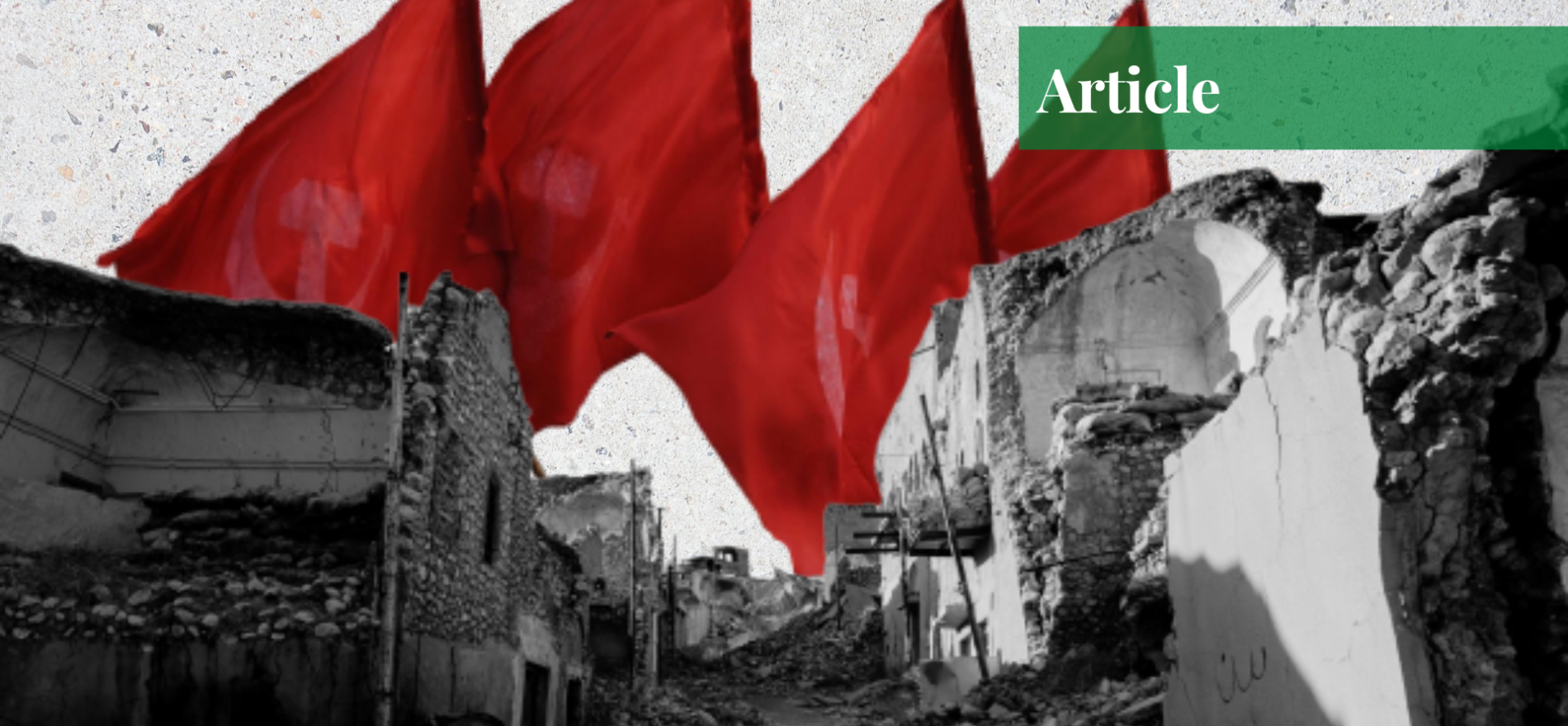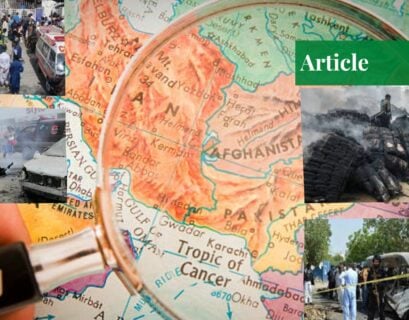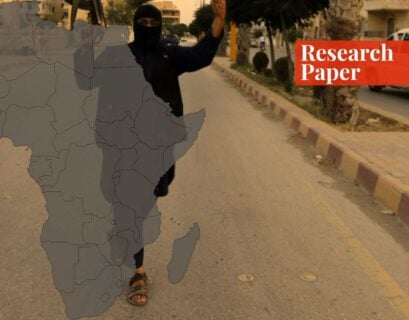Hafiza Noor ul Huda is currently pursuing her bachelor's in international relations from Lahore College for Women University. She has interned at the Centre for Global and Strategic Studies (CGSS), Islamabad. Her publications include "Understanding the Severity of Climate Change: Global Response and Way forward", published by the National Herald Tribune, and a paper titled "ASEAN Economic Community: An Initiative for Socio-economic Development", published by CGSS.
Defining Terrorism
Terrorism has its roots in the word “terror,” which comes from the Latin word “terrorem”, meaning great fear. The terms “terrorist” and “terrorism” originated during the French Revolution of the late 18th century. During the “Reign of Terror” under Maximilien Robespierre in the 1790s, the revolutionaries used terrorist acts against the royalists and counter-revolutionaries. Even during the 1870s, according to David Rapoport’s model of the four waves of modern terrorism, the terrorist groups targeted royalists and monarchs.
The purpose of this practice was to denounce the anti-state activities and uphold the new regime based on virtue and democratic reforms. From this point of view, it can be safely deduced that terrorism is inherently political. It is about pursuing power, acquiring power, and striving for socio-political change by the use of power.
However, terrorism is a much more complex phenomenon in its aims, motivation, rationale, and methods of achieving the aims. The ever-evolving nature of terrorism makes it hard to define it by only one standard definition. The common element of agreement amongst different definitions regarding terrorism is that it is violence or threat of violence to achieve some political change.
The techniques of terrorist groups involve inflicting all-out psychological, physical, and materialist damage targeting a large number of audiences. Although terrorism existed long before the 18th century, in the last decades it has become even deadlier—as highlighted by the four waves of modern terrorism—killing thousands each year.

Hoffman has laid down some key characteristics of terrorism, in his seminal work “inside Terrorism”, which says:
- It is a use of violence in pursuit of a political aim.
- It is about power.
- It is a calculated, planned, and organized act.
- It is perpetrated by a non-state entity.
- It has psychological repercussions.
The Oxford English Dictionary (OED) defines terrorism as “a phenomenon of political violence perpetrated by individuals belonging to an organization or ideological movement dedicated to revolutionary change—a change that they fervently believed can only be effected through violence or the threat of violence.”
On the other hand, the Federal Bureau of Investigation (FBI) defines terrorism as “the unlawful use of force or violence against persons or property to intimidate or coerce a government or its citizens to further certain political or social objectives.” These definitions indicate that terrorism is an anti-state activity with specified goals to bring radical changes in a given society. It could be pursued against the non-combatants to get attention to the cause.
The terrorist groups can also attack the governmental facilities, buildings, and institutions to challenge the writ of the government or to weaken the government, as the Jewish terrorist organization Irgun had done during its struggle against the British colonial rule in Palestine. Scholars have stated that it is impossible to define terrorism but an observer would “know it when they saw it”. Nevertheless, it is also required to understand its evolutionary process and historical aspects to further comprehend this intricate activity of spreading terror.
Evolution of Terrorism and its Theoretical Basis
Terrorism has a long history dating back to the 1st century when the extremist Jewish sect, also known as the Sicarii, used abducting and assassination of notable Jewish political and religious leaders to end the Roman occupation of Judea (southern part of Israel). The other sects of terrorists in the ancient world (11th century) were the Nizari who wanted to overthrow the Fatimid Caliphate and later, the Seljuk Empire by the means of assassinations of political and religious figures.
The attacks by terrorist groups in ancient times were discriminatory and used symbolic targeted violence to bring up change. While the history of modern terrorism has its roots in the following years of the French Revolution during 1793-1794. It was the first evident example of state-sponsored terrorism which involved the mass execution of anyone who was a royalist or counter-revolutionary or even suspected of being nostalgic to the ancient regime.
During this era, terrorism was considered as a positive connotation, associated with enforcing republicanism. Another example of state terrorism emerged during the 1930s with the rise of Benito Mussolini in Italy and Adolf Hitler in Germany. The meaning of terrorism again changed, it referred less to the revolutionary movement and more to mass repression by the totalitarian states against their citizens. It was applied to the authoritarian regimes of fascist Italy, Nazi Germany, and Stalinist Russia.
Their justification lies in the ultranationalist political ideology of fascism. Fascism emphasized militaristic nationalism and that individual interests are subordinate to the interest of the state. Mussolini termed the intimidation of the opponents or the enemies of the state as “…social hygiene, taking those individuals out of circulation like a doctor would take out a bacillus.” At that time, terrorism was associated with state practice, unlike today where terrorism is described as an illegitimate use of violence by the non-state actors.
The Four Waves of Modern Terrorism by Rapoport
To analyze the evolution of terrorism, David Rapoport’s model of the four waves of modern terrorism provides significant insights. Each of Rapoport’s four waves of modern terrorism is a historical phase of terrorism that reflects the dominant feature of the activity of terrorist groups of its time. The four waves of modern terrorism are anarchism, nationalism, leftists/Marxism, and religious fundamentalism. Each wave has its life cycle which Rapoport defines as phases of expansion and contraction, driven by common predominant energy in several countries.
First Wave: The Anarchist Wave
The first wave of terrorism started around the 1870s with the anarchist movement in Russia that proliferated throughout Europe and the Balkan region. The catalyst of this movement is the increasing consciousness about the illegitimacy of monarchies and the slow process of political reforms. In 1861 Tsar Alexander II of Russia promised some socio-political reforms but the promise was not fulfilled quickly which agitated the masses, whose hopes for change turned into aggression towards the system and a longing for freedom from the societal conventions.
Sergey Nechayev was the important revolutionary leader of the Russian anarchist movement and wrote a radical manifesto known as the “Catechism of a Revolutionary“. It guides the duties of a revolutionary. He focused on merciless destruction for achieving their aims. He also articulated the idea of propaganda by deed.
This anarchist movement was not only confined to Europe but also spread in the United States. The anarchists aimed to bring a revolution and eliminate any form of governmental authority and industrial institutions by assassinating heads of states and the key industrialists. This anarcho-terrorism is justified by the theory of anarchism that sees it as a criminal act that attacks an organized society and challenges the supreme authority.
The popular idea of anarchism is propaganda by deed which can be seen in the terrorist practice of the anarchist wave where the anarchists tend to support their cause by assassinating significant figures. Although they were united by the cause, their actions were mostly independent of the group and hence constituted a leaderless resistance. The anarchists managed to assassinate nine leaders of different countries, including US President William Mackinlay. The wave lasted till 1912 and declined with the state’s aggressive opposition and the commencement of World War I.
Second Wave: The Anticolonial Wave
The second wave started in 1920 with the end of World War I and remained till the 1960s. This era is marked with the practical manifestation of the ideology of nationalism. Nationalism asserts that each nation should have a right to self-govern, free from external interference, and that nation is only the righteous in exercising popular sovereignty.
After the Treaty of Versailles, many nations states emerged on the European map infusing nationalism and self-determinism in other parts of the world. A new trend appeared in which the nations which were not getting the right to self-govern and independence from their colonial masters started campaigns for autonomy and self-determination against the colonialist European powers.
Some anti-colonial movements used terrorist tactics to achieve their cause. These groups maintained the philosophy of self-determinism—advocating the right of a group or nation to determine its course. Many terrorist organizations like the Irish Republican Army (IRA), Irgun, Front de Liberation Nationale, Algeria (FLN), etc., struggled for colonial dissolution.
The terrorist tacts changed during this wave; there was a more complicated system, and their targets expanded. They considered the police as the eyes and ears of the government so, they attacked the police buildings, and officers and their families, for instance, the bombing of King David Hotel by Irgun’s terrorists. They used guerilla tactics like the hit and run method. These terrorists called themselves freedom fighters and proclaimed that their cause was greater and more legitimate than the anarchists’. These movements tapered off with the disintegration of the European empires.
Third Wave: The New Left Wave
The third wave of international terrorism started in the 1960s. During this era, terrorist groups used Marxist-socialist ideals to bring revolution and uproot the exploitative capitalist system. The philosophy of Marxism urged the working class to fight against the capitalist system and bring a world revolution and establish a classless society.
The Vietnam War is the major event of the third wave in which the Viet Cong’s struggle against the American troops inspired many revolutionaries and made them believe that the capitalist system can be changed. The leftist terrorist groups started developing throughout the West, e.g., American Weather Underground, the Italian Red Brigades, the West German Red Army Faction, and the Action Directorate in France.
Kidnapping, hijacking, and hostages taking were the main strategies of the third wave. Like anarchists, the leftists targeted the head of the states, and governments to achieve their targets. The most noteworthy event of the third wave happened in 1979 when the Red Brigades kidnapped and later killed the Italian prime minister, Aldo Moro. Other prominent targets were the British Ambassador to Ireland, Prime Minister Margaret Thatcher, and Jordon’s King Hussein. The new left wave started diminishing during the 1980s with the end of the Cold War.
Fourth Wave: The Religious Wave
The fourth and last wave of terrorism by Rapoport began in the 1980s and is ongoing. This wave is different from the other three waves of modern terrorism as it is motivated by religious beliefs and not by political goals. Criminologists develop a link between theology and the ideology of terrorism; they assert that the religious system convinces the believers that to eliminate evil from the society, utilizing militancy is the test of their faith. They believe that God demands it, so they turn to terrorism as a last resort to accomplish their aims.
The religious wave was fueled by the Iranian Revolution and the Soviet invasion of Afghanistan which paved the way for religious fundamentalism. The Soviet intervention gave rise to the jihadi sentiments and animosity towards westernization. The religious terrorists perceive that westernization is influencing their religious culture and blame their own country’s politicians for this.
For instance, Tehreek e Taliban Pakistan (TTP) negates the constitution of Pakistan and aims to build an Islamic government in the state because it believes that the state is not aligned with the Islamic principles. These religious militants consider secularization, modernization, and westernization as their specific enemies. Their goals can be varied, but the commonness is to establish a worldwide caliphate and exterminate infidels.
Strategically, they use suicide bombings of public areas, vehicles, and aircraft as weapons. Religious terrorism is not necessarily associated with only one religion (Islam), there are other terrorist organizations like the Lord’s Resistance Army (a Christian rebel group), Aum Shinrikyo (a Buddhist, Japanese cult), the white supremacy racist groups in the US, and the Christian Identity Movement. Religious terrorism is not about extremism, fanaticism, sects, rather about a fundamentalist or militant interpretation of the basic tenets. Currently, the world is amidst the fourth wave, and there are no explanations for when this will end.
Contemporary View on Terrorism
Currently, the world is experiencing violent religious terrorism. The advancements in technology associated with globalization have improved the capabilities of terrorist outfits. Their strategies, system, communication, and coordination have increased, resulting in a higher number of terrorist attacks in recent years. To spread their cause and get attention, they use the internet and international media.

Today terrorist organizations use the internet to recruit, radicalize and raise funds for their cause. They produce sophisticated propaganda through social media platforms like Facebook, Twitter, and YouTube. Although the world governments have developed countermeasures, a clash of ideas between fundamentalists and the modern West will still persist in the years to come.
Conclusion
Terrorism is a complicated phenomenon characterized by violence. It is used by every group – state and non-state actors – to justify their cause. By examining the evolutionary process of terrorism, it can be concluded that terrorism evolves with the changing global circumstances and preferences. It is more or less a response to a domestic, regional, or global environment by some politically or religiously motivated factions.
The strategies of terrorists were different in every era, influenced by that time’s technology as well. The causes of terrorism keep on changing throughout history, but there will always be a group of people who don’t accept the prevailing system and continue to sabotage that system until they bring their own one or meet their fate.
If you want to submit your articles and/or research papers, please check the Submissions page.
The views and opinions expressed in this article/paper are the author’s own and do not necessarily reflect the editorial position of Paradigm Shift.


















